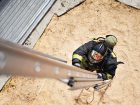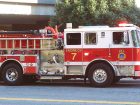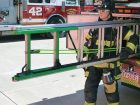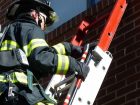
Features
Training
Back to Basics: The high-shoulder ladder throw
In the last few issues, we have focused on tasks that can be completed efficiently and effectively in situations with limited crews. At times, firefighters may be forced to work by themselves. The idea of single firefighter assignments or tasks may go against traditional teaching – to always work in pairs, at a minimum – but it’s wise to prepare for situations in which few members are available to respond.
July 17, 2017
By Mark van der Feyst
The high-shoulder ladder throw can be accomplished by one firefighter, be it the driver, the pump operator, the first firefighter of a two-person team, or even the officer.
The high-shoulder ladder throw is perfect for members riding newer fire trucks that have ladder compartments or ladder racks that fold down, or for the traditional static ladder rack positioned on the side of the truck.
The first step in making a successful ladder throw is to identify the middle of the ladder. This can be accomplished in several ways. It is a great idea to tag the ladder with useful information for firefighters; this can be used to identify the truck it belongs to and the mid-point of the ladder. Alternatively, spray paint can be used to mark the middle of the ladder. Different spray paint colours can be used to identify which ladders belong to which trucks. Marking the middle of the ladder also helps firefighters easily identify where to grab the ladder.
To ensure the high-shoulder ladder throw is effective, the halyard must be tied around the bottom rung of the bed section using a clove hitch. This ensures that one firefighter can raise the ladder and extend it without having to untie the halyard. To extend the fly section of the ladder, simply pull on the halyard and the ladder goes up.
The ladder – either in a compartment or on a ladder rack – must be orientated with the bed section facing the firefighter. This allows a single firefighter to pull the ladder out from the compartment at the mid-point of the ladder. The firefighter then places a shoulder under the bottom beam of the bed section at the mid-point, and walks the rest of the ladder away from the truck. This method also allows the firefighter to raise the ground ladder and extend the fly section easily, using one or two hands, with the halyard facing the firefighter.
To pull off the high-shoulder ladder throw, the ladder needs to rest completely on the firefighter’s shoulder. This method requires firefighters to become accustomed to balancing the ladder on one shoulder so that one hand is free to carry hand tools if necessary. One way to become accustomed to this type of carry is regular practice. I suggest practising this technique whenever you are checking in your truck. When you pull the truck out on the tarmac to check it in, pull the ladder off of the truck from the mid-point. Once pulled off the truck, try practising walking around with the ladder on your shoulder to get use to the weight and learn the balance point on your body in relation to the ladder.
Once the firefighter has reached the destination with the ladder, direct the butt spurs of the ladder into the ground and, with a single push on the beam, raise the ladder. At this point the ground ladder will be backwards; the fly section faces the building, while the bed section faces the firefighter. At this point, the firefighter can extend the fly section of the ladder.
Once the ladder has been extended, it is placed against the building. The butt end is to be moved out (away from the building) to allow the ladder tip to fall into place. Then, the ladder is flipped over so that it is properly oriented to the building, fly section out.
Bringing the ladder down is simply the opposite of how it went up.
Mark van der Feyst has been in the fire service since 1999 and is a full-time firefighter in Ontario. Mark teaches in Canada, the United States and India and is a local-level suppression instructor for the Pennsylvania State Fire Academy. Email Mark at Mark@FireStarTraining.com
” frameborder=”0″ allowfullscreen>
Print this page
Advertisement
- Truck Tech: How to prevent vehicle breakdown before it happens
- Volunteer Vision: Consistent training for peak performance



